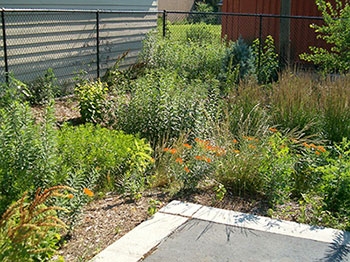
Many plants that do well in our Butte County Mediterranean climate flourish during the rainy season and can survive during the long dry summer. Gardens may receive too much rainwater when it is not immediately needed and too little when plant water demands increase. Annual rainfall in Butte County averages 26.6 inches in Chico, 30.7 inches in Oroville, and 58 inches in Paradise, with rain falling mostly between October and April.
With the current prolonged drought, we clearly must learn to save water up for the dry days to come. In California every drop of water counts.
Harvesting rain water is something we can all do. Every residence has two potential sources for harvesting rain to use in the yard: direct rainfall and rainfall from roofs.
Direct rain can be saved by thoughtful planning, including the incorporation of swales in the landscape. Swales are depressions dug into the ground that collect and store rain runoff, allowing the water to slowly seep back into the soil. A swale is lower at one end; this low end empties water into backyard ponds, lawns, or flower beds. Swales can be planted with native vegetation that is hardy and attractive, with the added benefit of providing habitat for birds and butterflies. Swales can be dug into pathways and then filled with water-retaining mulches like sand or gravel. Small-scale swales can be dug directly in flower beds and vegetable gardens, while larger-scale swales can be designed for entire neighborhoods. These landscape depressions can turn flooding problems into water assets by slowing runoff and allowing water to soak into the ground, thereby reducing runoff into sewer systems.
Roof rainfall can be collected in receptacles ranging from simple rain barrels to large sophisticated cistern systems. Unless a catchment is planned, water captured in small barrels will be exhausted very quickly once the rainy season ends. The expense for barrels or cisterns to capture roof rainfall makes the most sense when other water sources are very limited. While a one-inch rainfall on a 1500 square foot roof generates over 900 gallons of runoff, plants covering a one-tenth acre landscape use roughly 4,750 gallons of water per week during July.
Rain barrels attached to rain gutter downspouts hold about 55 gallons, an amount useful for keeping very small areas or container plants watered during our dry season. They can be as simple as garbage cans, covered between rains with lids to keep insects out. Commercially-produced rain barrels generally have a spigot that can be attached to a hose. Placing this type of rain barrel on raised cement blocks set over a leveled bed of gravel will put barrels higher to provide water pressure for using the hose. Rain barrels can be set up singly or connected in groups for any size yard. Commercial cisterns come in larger sizes. They require more yard space and some technical expertise for putting together the rain retrieval system. Whether home gardeners use swales, rain barrels, or cisterns to harvest winter rain for a dry day, the effort will be a welcome contribution to our current water conservation needs.